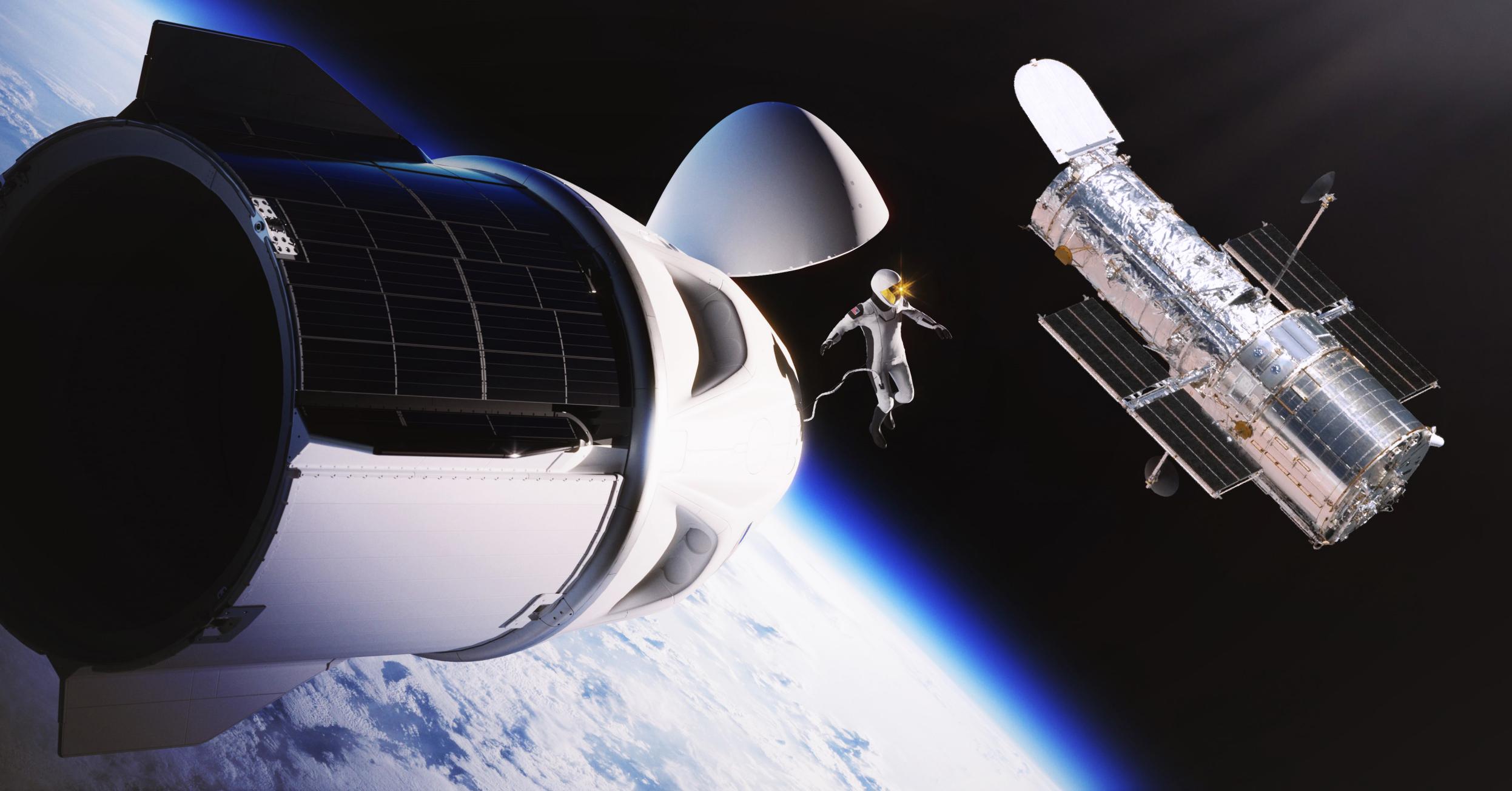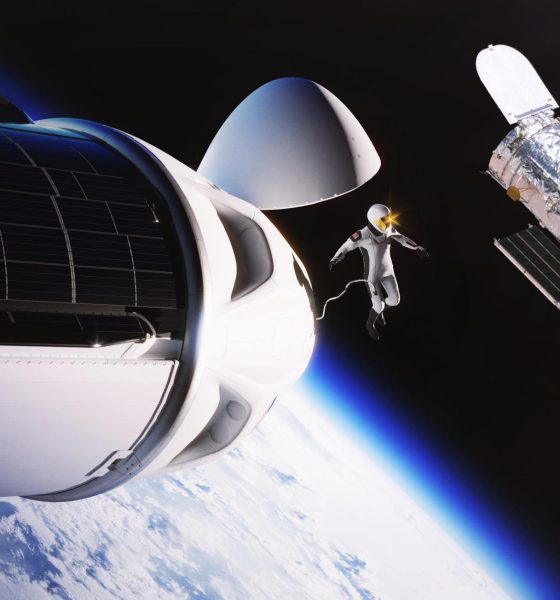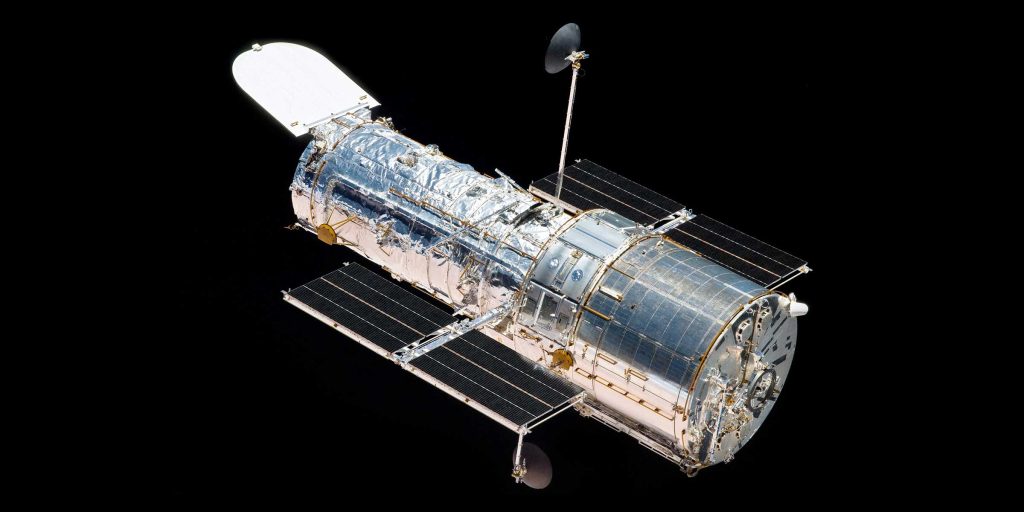

News
SpaceX wants to boost Hubble Space Telescope’s orbit with Dragon spacecraft
NASA and SpaceX have signed a Space Act Agreement to study the feasibility of boosting the orbit of the iconic Hubble Space Telescope, potentially ensuring that the highly successful observatory will remain operable well into the middle of this century.
Thanks to three servicing missions completed in the 1990s and 2000s, Hubble remains highly productive more than 32 years after its launch. NASA believes that that will remain the case until at least the late 2020s or 2030s. However, many components of the telescope have spent decades in the unforgiving environment of space, raising unsurprising concerns about their longevity.
More importantly, the inexorable march of time, gravity, and Earth’s atmosphere mean that Hubble is guaranteed to eventually reenter that atmosphere and burn up without intervention. That demise could come as early as the mid-2030s, but SpaceX thinks it could help extend the telescope’s viability into the 2050s.
NASA and SpaceX will spend the next six or so months discussing whether it’s possible to use Dragon to boost the telescope’s orbit back to a nominal 600 kilometers (~372 mi). Both parties say that the agreement will also investigate the possibility of Dragon servicing missions, which could be even more significant for Hubble. While a boost that large would likely keep it in orbit for decades to come, there’s no guarantee the telescope would remain functional to take full advantage of the extra time it would have.
During the fifth and final Space Shuttle servicing mission, NASA astronauts installed a docking adapter (Soft Capture Mechanism) on the Hubble Telescope. Although no concrete plans existed for any additional servicing missions, the forward-facing installation of that adapter has made this feasibility study possible.
In theory, that docking adapter could make boosting Hubble’s orbit far more feasible, safe, and affordable than a Shuttle-style crewed servicing mission. SpaceX’s Cargo Dragon 2 spacecraft has the same autonomous docking capabilities its crewed sibling has and costs less to launch and operate, so it’s not inconceivable that an uncrewed Dragon could autonomously dock with Hubble and boost its orbit. Jessica Jensen, SpaceX’s Vice President of Customer Operations and Integration, says that an uncrewed option will be studied alongside crewed servicing and orbit-boost alternatives.

According to Patrick Crouse, NASA’s Hubble Space Telescope project manager, without a reboost, NASA would need to consider a separate mission to ensure a controlled deorbit of the massive telescope by “the end of the decade.” The study’s targeted boost of “40 to 70 kilometers,” meanwhile, could extend the longevity of Hubble’s orbit by “15 to 20 years,” or well into the 2050s. But as a feasibility study, there’s a chance that it will conclude that using Dragon – crewed or uncrewed – to boost or service HST isn’t feasible. Ordinarily, the most likely outcome would be a conclusion that the project is feasible from a technical perspective but out of reach from a financial perspective.
Enter billionaire and private astronaut Jared Isaacman, who was directly involved in the September 29th press conference. In September 2021, Isaacman – alongside four others – became the first all-private astronaut mission in history to reach orbit. After the spectacular success of Inspiration4, Isaacman’s relationship with SpaceX has become even closer. In early 2022, the pair announced a new endeavor – the Polaris Program – that intends to conduct at least two or three more private astronaut launches over the next few years.
Expanding the scope of their joint ambitions, the Polaris Program intends to debut the world’s first privately developed EVA spacesuit, test spacecraft-to-spacecraft communications using Starlink’s network of space lasers, and culminate in the first crewed launch of SpaceX’s next-generation Starship rocket. On its own, the decision to privately fund and develop an EVA suit and pursue the ability to conduct EVAs out of Crew Dragon represents a major leap forward for SpaceX and private spaceflight if realized.
But crucially, when asked about the synergies between the Polaris Program, SpaceX, and NASA, Isaacman revealed that he and SpaceX are willing to undertake a sixth Hubble servicing mission more or less pro bono, “with little or no potential cost to the government.” According to Isaacman, it’s possible that “the study could result in [a Hubble servicing mission] becoming the second [Polaris Program] mission.”
Polaris Dawn, the program’s first mission, was recently delayed from a late-2022 launch target to March 2023. The four private astronauts assigned to the mission (including Isaacman himself) recently began training for the historic private EVA, which will see two of four astronauts attempt to briefly exit their Crew Dragon spacecraft in new SpaceX-designed suits. With a targeted apogee of 1400 kilometers (~870 mi), the mission will also attempt to break the record for the highest Earth orbit reached by astronauts, and the spacewalk attempt will also occur at a record-breaking altitude of 700 kilometers (~435 mi)

News
Tesla 2025 Holiday Update: Here’s what it includes, and what it’s missing

Tesla has finally announced the features for the 2025 Holiday Update, which includes a wide variety of new inclusions that are both functional and just for fun.
The new features are plentiful, but there were a handful of things we were expecting to see based on what we know. We don’t want to sound ungrateful, because there are a lot of great new things on the way with this update.
Here’s what was included:
Grok with Navigation Commands (Beta)
Grok will now have the ability to add and edit navigation destinations, which is a drastic improvement considering Tesla owners had to use their standard voice commands for this in the past.

The utilization of Grok will likely improve the navigation experience by offering some insight into your destination, including reviews and other points of interest nearby.
It will be enabled by using Grok’s “Assistant” personality.
Tesla Photobooth
“Turn your car into a photobooth! Take selfies from inside your Tesla & give yourself a makeover with fun filters, stickers, and emojis. Share with others right from the Tesla app.”
This feature will be available within the Toybox.
Dog Mode Live Activity
When using Dog Mode to keep your four-legged friend comfortable in the car, you’ll now be able to check in on them as it will share periodic snapshots of the cabin, along with live updates on temperature, battery, and climate conditions.

Dashcam Viewer Update
Dashcam clips are awesome, but they’re void of a lot of information, which could be useful in some instances, especially if there is an accident.

Now, there will be additional details included on each Dashcam clip, like speed, steering wheel angle, and Self-Driving state.
Santa Mode
New graphics, trees, and a lock chime are now available.

Light Show Update
A new Light Show, called Jingle Rush, will be available.
Custom Wraps and License Plates in Colorizer
Colorizer will now be known as “Paint Shop” in the Toybox. You will now be able to personalize your Tesla Avatar with window tints, custom wraps, and license plates. Preloaded designs will be available, but owners will be able to use their USB Flash Drives to create one that suits their style.

Navigation Improvements
Changing the order of your destinations will be easier through a new “Favorites” tab, and Home and Work can now be set by dropping a pin.
There will also be “Suggested Destinations,” which will be determined through recent trips and habits while parked.
Supercharger Site Map
Perhaps the most significant feature of the Holiday Update, Tesla is adding a 3D view of select Tesla Superchargers by tapping “View Site Map.”
When navigating to a location with this capability, the site layout, live occupancy, and nearby amenities will be available. Drivers will also be able to choose which stall to Supercharge.

This is only available at a handful of locations currently, but it will expand to more Superchargers as it becomes more robust.
Automatic Carpool Lane Routing
Navigation will include an option to utilize carpool lanes. Your route will automatically choose the carpool lane when eligible.
Phone Left Behind Chime
If the in-car occupant detection system does not see anyone in the car and there is a phone key, or if a phone is left inside the cabin, your Tesla will chime a few seconds after the doors close.
Charge Limit Per Location
You can now save a charge limit for the current location while parked and it will be applied automatically the next time you charge there.
ISS Docking Simulator
In a SpaceX collaboration, Tesla has added this game to its in-car Arcade:
“Become an astronaut and prove your skills by docking with the International Space Station. Control & guide the rocket in this 3D docking simulator game using a set of controls based on actual interfaces used by NASA astronauts.”
Additional Improvements
-
Enable or disable wireless phone charging pads in Controls > Charging (S3XY) or Controls > Outlets & Mods (Cybertruck)
-
Add Spotify tracks to your queue right from the search screen & scroll through large Spotify playlists, albums, podcasts, audiobooks & your library seamlessly, without paging
-
Take the vibes up another level with rainbow colors during Rave Cave. Accent lights color will change along with the beats of your music. App Launcher > Toybox > Light Sync
-
Lock Sound now includes Light Cycle from Tron Mode. Toybox > Boombox > Lock Sound
What’s Missing
There are a handful of features we expected to see with the Holiday Update, but were not included.
Banish Feature
Tesla has been teasing the Banish functionality for quite a few years, but evidently, it is not quite there yet.
Banish will allow owners to get out of their vehicle at the entrance of their destination, and the car will go find a spot and park itself. Some refer to it as “Reverse Summon.”
Apple CarPlay
With all of the rumors regarding Apple CarPlay and then the evidence that Tesla was working to bring CarPlay to vehicles, we really expected it to come with the Holiday Update.
We’re not upset it’s not here, though. Tesla’s in-car UI is significantly better, at least in our opinion.
Parking Spot Selection
One of the biggest gripes about the new Arrival Features with Full Self-Driving v14 is that choosing a set parking spot is not available. This is especially frustrating for Tesla owners who rent or live in townhouse neighborhoods or apartment complexes with assigned parking.
Tesla seems to be working on this based on the release notes for v14.2, where it said future capabilities would include Parking Spot Selection.
News
Man credits Grok AI with saving his life after ER missed near-ruptured appendix
The AI flagged some of the man’s symptoms and urged him to return to the ER immediately and demand a CT scan.

A 49-year-old man has stated that xAI’s Grok ended up saving his life when the large language model identified a near-ruptured appendix that his first ER visit dismissed as acid reflux.
After being sent home from the ER, the man asked Grok to analyze his symptoms. The AI flagged some of the man’s symptoms and urged him to return immediately and demand a CT scan. The scan confirmed that something far worse than acid reflux was indeed going on.
Grok spotted what a doctor missed
In a post on Reddit, u/Tykjen noted that for 24 hours straight, he had a constant “razor-blade-level” abdominal pain that forced him into a fetal position. He had no fever or visible signs. He went to the ER, where a doctor pressed his soft belly, prescribed acid blockers, and sent him home.
The acid blockers didn’t work, and the man’s pain remained intense. He then decided to open a year-long chat he had with Grok and listed every detail that he was experiencing. The AI responded quickly. “Grok immediately flagged perforated ulcer or atypical appendicitis, told me the exact red-flag pattern I was describing, and basically said “go back right now and ask for a CT,” the man wrote in his post.
He copied Grok’s reasoning, returned to the ER, and insisted on the scan. The CT scan ultimately showed an inflamed appendix on the verge of rupture. Six hours later, the appendix was out. The man said the pain has completely vanished, and he woke up laughing under anesthesia. He was discharged the next day.
How a late-night conversation with Grok got me to demand the CT scan that saved my life from a ruptured appendix (December 2025)
byu/Tykjen ingrok
AI doctors could very well be welcomed
In the replies to his Reddit post, u/Tykjen further explained that he specifically avoided telling doctors that Grok, an AI, suggested he get a CT scan. “I did not tell them on the second visit that Grok recommended the CT scan. I had to lie. I told them my sister who’s a nurse told me to ask for the scan,” the man wrote.
One commenter noted that the use of AI in medicine will likely be welcomed, stating that “If AI could take doctors’ jobs one day, I will be happy. Doctors just don’t care anymore. It’s all a paycheck.” The Redditor replied with, “Sadly yes. That is what it felt like after the first visit. And the following night could have been my last.”
Elon Musk has been very optimistic about the potential of robots like Tesla Optimus in the medical field. Provided that they are able to achieve human-level articulation in their hands, and Tesla is able to bring down their cost through mass manufacturing, the era of AI-powered medical care could very well be closer than expected.
News
Tesla expands Model 3 lineup in Europe with most affordable variant yet
The Model 3 Standard still delivers more than 300 miles of range, potentially making it an attractive option for budget-conscious buyers.

Tesla has introduced a lower-priced Model 3 variant in Europe, expanding the lineup just two months after the vehicle’s U.S. debut. The Model 3 Standard still delivers more than 300 miles (480 km) of range, potentially making it an attractive option for budget-conscious buyers.
Tesla’s pricing strategy
The Model 3 Standard arrives as Tesla contends with declining registrations in several countries across Europe, where sales have not fully offset shifting consumer preferences. Many buyers have turned to options such as Volkswagen’s ID.3 and BYD’s Atto 3, both of which have benefited from aggressive pricing.
By removing select premium finishes and features, Tesla positioned the new Model 3 Standard as an “ultra-low cost of ownership” option of its all-electric sedan. Pricing comes in at €37,970 in Germany, NOK 330,056 in Norway, and SEK 449,990 in Sweden, depending on market. This places the Model 3 Standard well below the “premium” Model 3 trim, which starts at €45,970 in Germany.
Deliveries for the Standard model are expected to begin in the first quarter of 2026, giving Tesla an entry-level foothold in a segment that’s increasingly defined by sub-€40,000 offerings.
Tesla’s affordable vehicle push
The low-cost Model 3 follows October’s launch of a similarly positioned Model Y variant, signaling a broader shift in Tesla’s product strategy. While CEO Elon Musk has moved the company toward AI-driven initiatives such as robotaxis and humanoid robots, lower-priced vehicles remain necessary to support the company’s revenue in the near term.
Reports have indicated that Tesla previously abandoned plans for an all-new $25,000 EV, with the company opting to create cheaper versions of existing platforms instead. Analysts have flagged possible cannibalization of higher-margin models, but the move aims to counter an influx of aggressively priced entrants from China and Europe, many of which sell below $30,000. With the new Model 3 Standard, Tesla is reinforcing its volume strategy in Europe’s increasingly competitive EV landscape.








